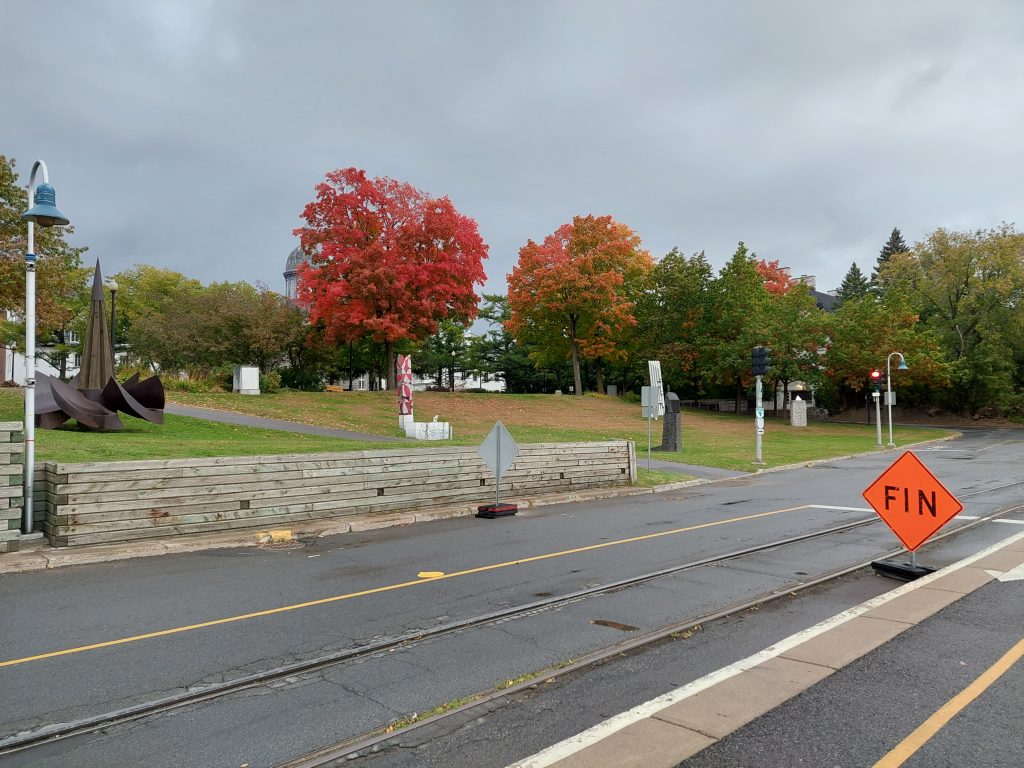On Fallen Leaves. About the Cover Artwork
Jérôme Melançon
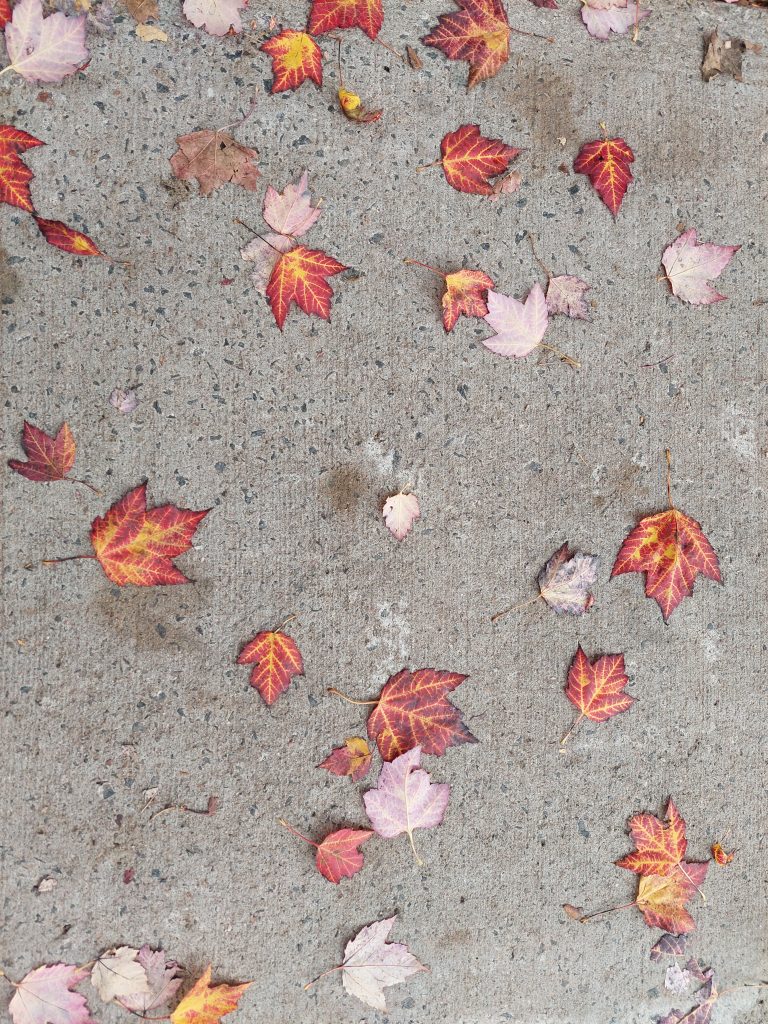
Even in moments of deep contestation and reflection, or prolonged moments of study, we need rest and beauty. We created this book with a view to support colleagues and students – all of them new colleagues – as well as other collaborators in the work of anti-colonial and decolonial action, study, and thought. This support means sharing more than concepts, ideas, and arguments; it also entails sharing joy and beauty.
The photograph you will find on the cover of this book and at the top of this page features small maple leaves, bright red and yellow against the cement of a sidewalk darkened by rain that has become sitting water and has entered the porous ground. Their beauty inspired the Canadian flag and brings tourists to the northeastern area of the continent, but it is the beauty of an upcoming decay. Most of these leaves have been trampled upon already, torn, flattened; some of them were recently sonorously crumpled, crisp and ready to crack under pressure, now soggy and helpless in their new form, unable to withdraw or curl up any more for the moment. Their beauty does not draw the eye that is preoccupied with a destination or with the life that hangs on to branches, still, unmoved. Others among the leaves are paler for having been flipped upside down. They gather no more sun, they have lost their function.
I did not retouch the photograph with a filter or with the effects various software can create. I did not arrange the leaves on the ground. I merely picked a location, a few angles, a frame, and then one picture among many. I selected these maple leaves twice, then. Once for photography, once for the cover. I took other photographs nearby, around the same trees, in the same location as far as maps are concerned.
A few steps away, there is a bust of Pierre Gaulthier de Varennes, Sieur de La Vérendrye. The bust is part of a monument celebrating the 300th anniversary of the founding of the city of Trois-Rivières in 1634, ninety-nine years after Jacques Cartier planted a cross in the same area. Since Trois-Rivières was a nodal point in Indigenous trade, it became important to the fur trade. It eventually became an early site of industrialization on the Saint-Lawrence River at the Saint-Maurice Ironworks (a Rue des Forges still exists, as does the publisher Écrits des Forges), before becoming a central part of the forestry and paper industry in Canada. The paper industry was a logical way to continue the extraction of lumber from the forests of the area that until then was used to feed the ironworks.
This history, as it can be found on Trois-Rivières’ Tourism site in August 2024, erases the Indigenous presence as surely as have the creation of the fort, towns, and city, as surely as the extraction of iron ore and wood, as surely as their pushing back away from the river or further to the northeast on the coast. As surely as the monument to the founders of Trois-Rivières and to La Vérendrye, first among them – the explorer and fur trader who brought New France to the prairies, to the Red River, falsely said on the plaque to have discovered the Rocky Mountains (one of his sons arrived nearer, thanks to the people who already lived there), and who brought back so many Indigenous slaves that his superiors, including the Governor of New France, did not know what to do with them.
A few meters away from the monument, a large lamp sits on the ground, angled up to gloriously light the monument at night:
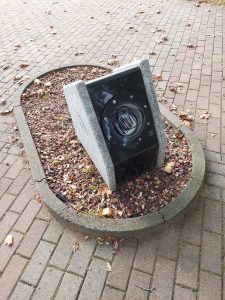
When I visited Trois-Rivières in 2022, somone had scribbled over the lamp, covering the light of colonialism celebrating itself. That dimmed light would fall on the word “Coloniseur” scribbled in black with the same felt pen on the bottom of the plaque commemorating the birthplace of La Vérendrye.
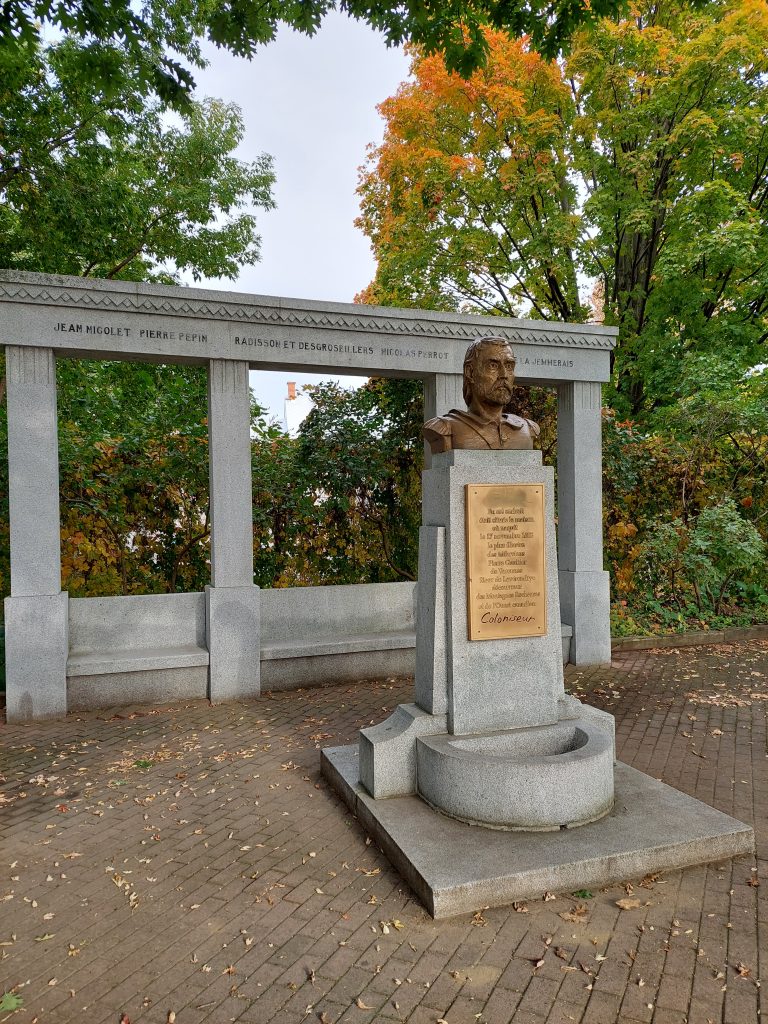
On the plaque, a word had previously been scratched. I cannot quite make it out, but I can’t help but see letters that look like they make up the acronym FLQ, making me focus on the possible ties between La Vérendrye and the Front de Libération du Québec. The opposition between the two sets of graffiti brings my attention to the contradiction inherent in an attempt at national liberation by the people who continued to occupy Indigenous lands. I grew up with the idea that French Canadians had been colonized and my contribution to another part of the Settler Colonialism in Canada project focuses on retelling that story. Over the last several years, I have spent a good amount of time to learn and understand the history of French, French Canadian, and Francophone, generally at the same time Catholic, colonialism. As these graffiti indicate, this history is being shared, it is a subject of reflection, it serves to chip away at the foundations for Canadian and Québecois settler institutions and legitimacy.
Further on, the walking paths along the Saint-Lawrence River cross a set of train tracks. These tracks are critical infrastructure to the capitalist economy and were the main route for the colonization of much of Canada’s current territory. They are also common sites of contestation through blockades. Cement blocks lay there, waiting to be moved to block paths, brought to another use in the meantime by another set of graffiti that can help block paths of thinking:
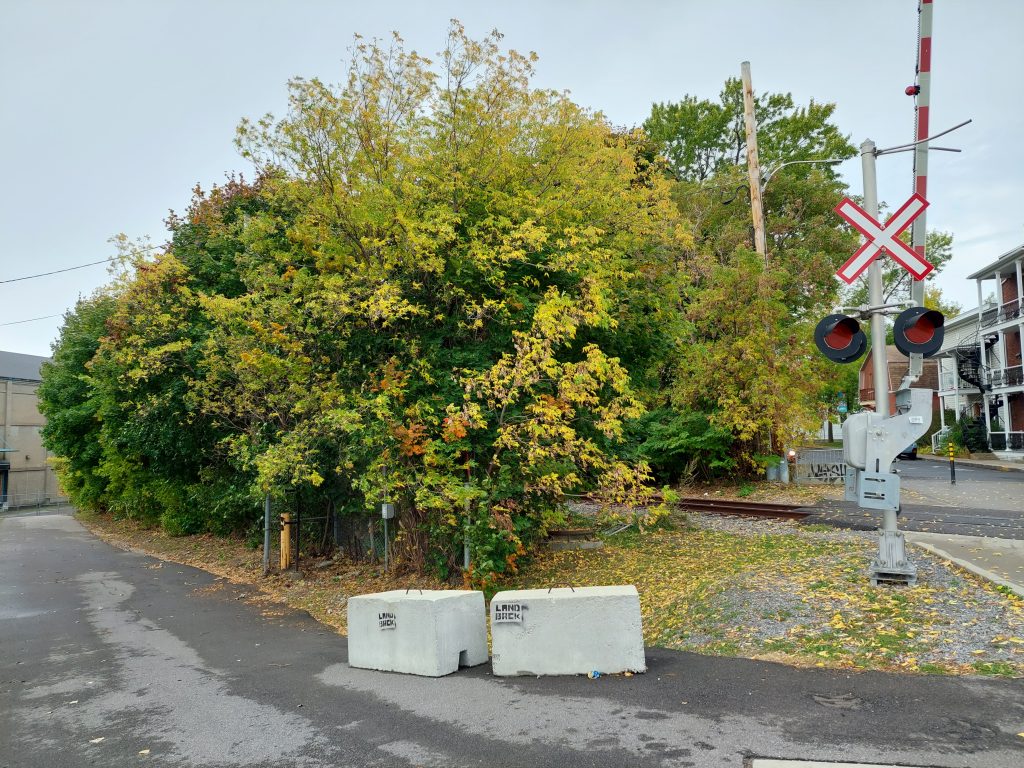
“Land back” is the horizon of decolonial work and critique, the political horizon of settler colonial studies. It is the ground for solidarity and for a coexistence that is respectful of individual and collective self-determination. In this picture, fewer trees were ready to lose their leaves, some wouldn’t at all. Every metaphor has its limits. The photograph on the cover of this book shows maple leaves that have been and will be trampled, colours that the Canadian flag did not include, colours that perhaps belong more to the four-coloured medicine wheel, this relatively contemporary teaching tool meant to facilitate Indigenous teachings and symbolize Indigenous knowledge against colonialism’s attempts at destroying them. It lends itself to illustrate domination and its reversal. But the trees remain alive, and the leaves will feed more life as well. Colonial domination continues, takes on new forms. Colonialism is certainly not a season. It is not a tree, it will not be chopped down or uprooted. We ought not to trample leaves or fight against trees; we ought not utter words for their own end or because they will be admired by others and replace trees on paper (or their virtual simulation on screens). There is no one within the frame of the photographs I have taken. They are not sites of struggle, they merely present traces of struggle. I want them to be reminders that we must find joy and beauty, and take comfort in moments of conceptual clarity and slight, glimmering social, economic, cultural, political transformation, which can only take place as we interact with other people to interrogate and reorient our practices and relations.
